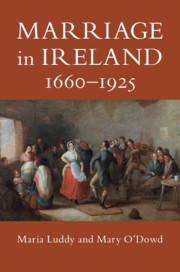Book contents
- Marriage in Ireland, 1660–1925
- Marriage in Ireland, 1660–1925
- Copyright page
- Dedication
- Contents
- Figures
- Illustrations
- Tables
- Acknowledgements
- Abbreviations
- Introduction
- Part I What Is a Marriage?
- Part II Ways to Marriage
- Part III Happy Ever After?
- Part IV The Unmaking of Marriage
- Conclusion
- Select Bibliography
- Index
- References
Select Bibliography
Published online by Cambridge University Press: 04 June 2020
- Marriage in Ireland, 1660–1925
- Marriage in Ireland, 1660–1925
- Copyright page
- Dedication
- Contents
- Figures
- Illustrations
- Tables
- Acknowledgements
- Abbreviations
- Introduction
- Part I What Is a Marriage?
- Part II Ways to Marriage
- Part III Happy Ever After?
- Part IV The Unmaking of Marriage
- Conclusion
- Select Bibliography
- Index
- References
- Type
- Chapter
- Information
- Marriage in Ireland, 1660–1925 , pp. 412 - 433Publisher: Cambridge University PressPrint publication year: 2020

